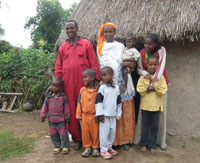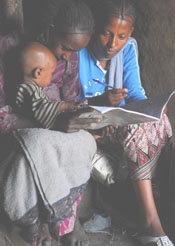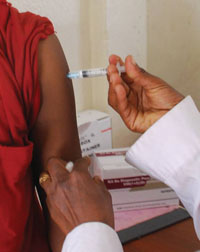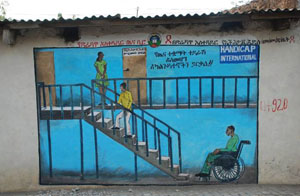Use 'Print preview' to check the number of pages and printer settings.
Print functionality varies between browsers.
Printable page generated Monday, 10 November 2025, 7:34 PM
Health Management, Ethics and Research Module: 7. Principles of Healthcare Ethics
Study Session 7 Principles of Healthcare Ethics
Introduction
Ethics is about the values that should be respected by all healthcare workers while interacting with individuals, families and communities. Ethics may sometimes be considered a scary term by some healthcare professionals because it is a word that may bring to mind an accusation of wrongdoing or mistakes, but this is not the case.
In this study session you are going to cover the concepts and principles of ethics that are relevant to your work as a Health Extension Practitioner. This will enable you to identify some of the most important ethical issues and then find out how to work to resolve them. Working to clear, consistent ethical principles is one of the most important components for delivering quality healthcare for individuals, families and the community at large.
This study session mainly focuses on ethical issues that you may face in your day-to-day practice and introduces some of the mechanisms you can use in order to resolve them.
Learning Outcomes for Study Session 7
When you have studied this session, you should be able to:
7.1 Define and use correctly all of the key words printed in bold. (SAQs 7.1, 7.2, 7.3 and 7.4)
7.2 Describe the basic principles of confidentiality and truthfulness. (SAQ 7.1)
7.3 Describe the basic principles of autonomy and informed consent. (SAQ 7.2)
7.4 Describe the basic principles of beneficence and nonmaleficence. (SAQ 7.3)
7.5 Describe the basic principles of distributive and social justice. (SAQ 7.4)
7.6 Illustrate your understanding of the ethical theories covered in this study session through the use of examples and case studies. (SAQ 7.5)
7.1 Ethical issues in healthcare work
Your work as a Health Extension Practitioner will involve ethical issues – even if you are not really aware that this is the case. Everybody has ethical issues in their lives and ethical theory can help us all to understand these issues – and work out ways of dealing with them.
Ethics is the branch of philosophy (Box 7.1), which takes a systematic approach to define social and individual morality – the fundamental standards of right and wrong that a whole society, as well as individuals, learn from their culture and peers. Perhaps you have already started to think about some things in your own life where you have had to take important decisions that might have an ethical component? For example, how should you look after your family when conflicts arise?
How should you deal with people in your community who present you with problems that are difficult to resolve? All these aspects of living your life involve ethical issues (Figure 7.1).

Box 7.1 What is philosophy?
Philosophy is the study of general and fundamental problems, such as existence, knowledge, values, reason, mind and language. It is distinguished from other ways of addressing such problems by its critical, generally systematic approach and its reliance on rational argument.
7.1.1 Two important ethical theories
In this study session you will learn about two of the most relevant ethical theories for your professional practice as a Health Extension Practitioner. These are called utilitarianism and deontology.
Utilitarianism considers an action as morally right if its outcomes or consequences are good for the greatest number of the population. It focuses on ‘the greatest good for the greatest number’. This theory disregards individual rights and considers the welfare of the greatest majority to be the most important factor. For example, it might be necessary to drain a particular pond because it is the breeding ground for mosquitoes – although this might be difficult for the farmer on whose land it is situated (Figure 7.2). In this situation the welfare of the greatest number of people is more important than the rights of the individual farmer.

Deontology, on the other hand, considers the way that things are done rather than focusing just on the consequences. This type of ethics holds at its core the respect for fundamental rights, such as the right to truth, privacy and the fulfilling of promises (Figure 7.3). Deontology considers the rightness or wrongness of an action. For instance, someone who believes that lying is always wrong, even if a lie might accomplish some good for individuals and society, is following the principles of deontology – although they may never have heard of the theory.

Imagine that a healthworker tells a mother of ten children that if she takes oral contraceptive pills they will be 100% effective in preventing another pregnancy, and that the pills have no side-effects. Is this approach an example of utilitarianism or deontology?
The healthcare provider has given wrong information (lying) because there is no 100% effective contraceptive which is without side-effects. However, using contraception has a great benefit to the health and wellbeing of the mother in particular and her family in general. Therefore, the approach taken by the healthworker is an example of utilitarianism, because it contains a lie (so it cannot be deontology), but it may yield a benefit to the woman, her partner and her ten children.
7.2 Ethics in practice
In this section you will be able to learn some of the key principles that will help you to think about ethical decisions which you may come across in your work.
The five main principles of ethics are usually considered to be:
- Truthfulness and confidentiality
- Autonomy and informed consent
- Beneficence
- Nonmaleficence
- Justice.
Some of these are difficult words, but in this study session you will be able to consider each of them in turn, using examples that will be familiar to you. This will help you to see how ethical principles are present in almost every aspect of your health work and daily life.
7.2.1 Truthfulness and confidentiality
Two concepts that you may commonly face in your day-to-day practice are truthfulness and confidentiality. Truthfulness is about telling the truth to someone who has the right to know the truth. For example, if you have been informed about the result of an HIV test taken by someone in your community who then asks to know his/her result, you should tell the person the truth even though this might be very upsetting to that person. The concept of truthfulness urges the professional not to lie.
On the other hand, the concept of confidentiality urges you to keep a secret – by which we mean knowledge or information that a person has the right or obligation to conceal (Figure 7.4). For example, if the family of a person who has had an HIV test demands that you give them the result, you must not tell them. You must keep the result confidential unless your client gives you permission to tell their family.

The professional obligation to keep a secret arises from the fact that harm will almost certainly follow if the information is revealed. There are three types of secrets:
- Natural secret: information which, if revealed, is harmful by its nature.
- Promised secret: information that we have promised to conceal which, if broken, leads to public mistrust.
- Professional secret: knowledge which, if revealed, will harm the client, the profession and the society that obtain services from the profession. A professional secret is the most serious of all secrets, because its violation can cause the greatest harm.
Case Study 7.1 Chaltu faces a dilemma
Chaltu, a Health Extension Practitioner, is responsible for providing community healthcare for 2,500 households including Mr Gadisa’s family.
Mr Gadisa’s life is based on farming. He does not have any extra income other than the income he gets from farming. One morning Chaltu went to Mr Gadisa’s house to provide health education on family planning to W/ro Bekelech, wife of Mr. Gadisa. While she was having a conversation with her, Almaz, their sixteen-year-old daughter, interrupted the conversation and asked Chaltu to sit and discuss a private health issue with her.
Almaz began by telling Chaltu that this is a private issue and that she should not tell this to anyone, even her parents and other family members. She said, ‘I have a serious problem. Please listen to me attentively. Three months ago, when I went to fetch water for my parents from a lake which is located 3 km away from my house, I was raped by someone whom I don’t know. I saw my last menstruation three months ago. In addition I have a foul-smelling discharge from my birth canal. I regularly wash my genitals to remove the discharge, but I can’t get rid of this discharge. Now I am asking you to provide me with medicine for my problem and help me with sisterly advice.’
Chaltu sat sadly for a long period of time without giving her a response, thinking about what to do in her mind.
- a.What ethical issues do you think are raised in Case Study 7.1?
- b.Which of the following do you think that Chaltu should do? Explain your reasons.
- Option 1: Do nothing and hope that someone else deals with this problem.
- Option 2: Tell Almaz that she must immediately tell her parents what has happened to her.
- Option 3: Refer Almaz to the health centre for pregnancy testing and treatment of her infection.
- Option 4: Ask Almaz to come to see her at a place that will be confidential so that more details can be found out.
You may have raised the following issues:
- a.There are immediate ethical issues of confidentiality involved in this situation. Chaltu cannot keep these problems to herself, she has to share her concerns with the healthworkers at the health centre who will be able to treat any infection that Almaz has in her birth canal, and also check if she is pregnant from the rape. But she needs to maintain confidentiality on Almaz’s behalf and not tell her parents or anyone else about the rape that has occurred, or the problems that have followed on from the rape.
b.Option 1 is certainly not correct. As a Health Extension Practitioner Chaltu has a duty to help the people in her community. This is especially the case when their problems are difficult. You will have an opportunity to learn more details about the rights and responsibilities of Health Extension Practitioners in a future study session.
Option 2 is probably not a good idea either. Almaz needs to know that she will get support for her problems and will pick her time to tell her parents.
Option 3 is certainly essential because Almaz has problems that need to be sorted out, but which are above the competence of an Health Extension Practitioner.
Option 4 is a good idea as well. Supporting Almaz is not just a matter of referring her for help at the health centre. She will need ongoing help and needs to know that her Health Extension Practitioner is willing to offer this support in a comforting and confidential manner.
Case Study 7.1 clearly concerns the issue of confidentiality between a health practitioner and a client. It also raises a number of issues about autonomy and informed consent which you will learn about next.
7.2.2 Autonomy
Autonomy is another ethical principle that you may already be aware of, but not know by that name. The term refers to every individual’s right of self-determination, independence and freedom to make their own choices. In the context of healthcare, the concept of autonomy is most concerned with the ethical obligation of the practitioner to respect their clients’ right to make decisions about their own health. Autonomy must be respected even if you, as the healthcare provider, do not agree with the client’s decision. For example, in Case Study 7.1, Chaltu may feel that Almaz’s parents should know what has happened to their daughter, but you must respect Almaz’s right to maintain confidentiality about her condition.
However, there are conditions in which that personal choice or autonomy may be restricted because of concern for the wellbeing of the community. For instance, if a communicable disease, such as tuberculosis, is diagnosed, clients can be required to take prescribed medication and may have to be isolated to prevent the spread of the infectious agent to others.
7.2.3 Informed consent
Informed consent means that each person who has any sort of procedure done to them in a healthcare context should give their approval for that procedure to be done to them. In order to be fully informed, it is the duty of the healthcare worker to tell the person exactly what the procedure will involve as well as the things that might happen if the procedure is not carried out. In Case Study 7.1 it is clear that Almaz will need further treatment at the health centre and that she will need to give her informed consent for this to take place. There is an ethical obligation on Chaltu, her Health Extension Practitioner, to explain to Almaz what will happen at the health centre, but also the possible consequences if she does not attend.
Which of the following healthcare procedures that might be undertaken by a Health Extension Practitioner require informed consent?
- a.Getting the community together to construct a new latrine.
- b.Immunizing a pregnant woman with tetanus toxoid.
- c.Testing a young boy to see if he has malaria.
- d.Distributing an Insecticide Treated Bed Net (ITN) to a family.
Procedures b. and c. certainly require informed consent to be given. The Health Extension Practitioner should explain the procedure to their patient on each occasion and be prepared to answer their questions and concerns. If the patient is under the age of consent, the parents have to give their informed consent. Constructing a new latrine or supplying ITNs are important parts of the preventive work of every Health Extension Practitioner, but do not require such a degree of informed consent. However, even these preventive activities need to be explained so that they will be adopted by members of the community.
Informed consent is implied in much of the work that Health Extension Practitioners do. In other words if a mother brings her child to the Health Post to be immunized, informed consent is necessary because the Health Extension Practitioner is performing a procedure that has benefits, but may also have side-effects. However, the act of bringing the child for the procedure implies consent, as does attending for a contraceptive injection (Figure 7.5). But Health Extension Practitioners should always explain what they are doing and how it impacts on individuals, their families and the wider community.

7.2.4 Beneficence and nonmaleficence
Beneficence is pronounced ‘be-neffi-sens’.
Nonmaleficence is pronounced ‘nonma-leffi-sens’.
In this section you will be able to learn about two important ethical concepts which may be new to you, but which are relevant for your practice. These are called beneficence and nomaleficence. The term beneficence tells you about ‘doing good’ for your client, for instance by providing immunization.
From your own experience of receiving or witnessing health services at community level, can you suggest some examples of health interventions that demonstrate beneficence by health workers?
We cannot know for sure what examples you suggested, but here are some you may have thought of:
- Providing antenatal care for pregnant women.
- Teaching new mothers about breastfeeding.
- Health education about family planning, personal hygiene, preparing nutritious food with little money, etc.
- Immunization.
On the other hand, the concept of nonmaleficence tells you to ‘do no harm’ either intentionally or unintentionally to your clients, for instance, not abandoning a client who is in need of your services. As you have seen in Case Study 7.1, Chaltu must not abandon Almaz and leave her to manage her problems without professional help. However, there are circumstances in which it is impossible to ‘do good’ and ‘avoid doing harm’ all at the same time. For instance, you may plan to provide birth control to all the women in your locality who are in need of it, but resource availability, cultural beliefs of the community, clients’ reaction to the service and other factors can limit you from doing good to the greatest number. Moreover, you cannot always avoid doing harm to a client; for instance, in times when a communicable disease arises in your vicinity, you may have to suggest isolating individuals with the infection against their will to contain the spread of the disease and for the good of the majority.
7.2.5 Justice
In Sections 7.2.1 to 7.2.4 you studied the concepts of confidentiality, autonomy, informed consent, beneficence and nonmaleficence. In this final section, you will be able to learn about the concept of justice, which is an important concept that will help you during your interaction with individuals, families and communities at large.
Justice is a complex ethical principle and it entails fairness, equality and impartiality; in other words, it is the obligation to be fair to all people. Most Health Extension Practitioners will understand about justice without necessarily having come across the word itself. The concept of justice will become clearer if you understand the meaning of two categories of justice: distributive justice and social justice.
Distributive justice means that individuals have the right to be treated equally regardless of ethnic group, gender, culture, age, marital status, medical diagnosis, social standing, economic level, political or religious beliefs, or any other individual characteristics. Everyone should be treated in the same way.
Social justice is based on the application of equitable rights to access and participation in all aspects of goods and services provided in a society, regardless of their individual characteristics. Everyone should have access to the same things that might improve their health. As a Health Extension Practitioner, you will be able to carry out distributive and social justice by enabling the inclusion and empowerment of all people living within your area to exercise their rights (Figure 7.6). You can understand the concept of justice from the examples in Case Study 7.2.

Case Study 7.2 Justice challenge
Example 1: Suppose a Health Extension Practitioner, Fantaye, visits Mr Lemma’s family to carry out routine antenatal care and check the pregnancy status of Mr Lemma’s wife, W/ro Lemlem. The family of the Health Extension Practitioner has a family dispute with Mr Lemma’s family and she only spends a few minutes with W/ro Lemlem and doesn’t tell her about all the services that are available for women when they are pregnant.
Example 2: Another Health Extension Practitioner is working in a community which is spread out over a large rural area. She is too lazy to go to the farthest homes to invite them to participate in an environmental sanitation campaign.
Look at the two examples in Case Study 7.2. Are these examples where social justice or distributive justice is not being carried out?
In both these examples justice is not being carried out. It is not fair that someone gets poorer services because they come from a particular family that is in dispute with the Health Extension Practitioner (lack of social justice) or live too far away (lack of distributive justice) to be included in preventive health activities.
Why is justice important?
If you are not fair to individuals and community groups in your vicinity while practising your profession, you will not be able to gain public trust and this will negatively affect your practice. As a Health Extension Practitioner you should be fair and maintain high ethical standards at all times, including confidentiality and truthfulness towards all your clients equally. However, as some of the examples in this study session have shown, you will be faced with dilemmas that are difficult to resolve in harmony with the concepts of respecting autonomy and informed consent, and reconciling the demands of beneficence and nonmaleficence. In Study Session 8 there will be further examples of ethical dilemmas for you to think about and learn from.
Summary of Study Session 7
In Study Session 7, you have learned that:
- Ethics is the branch of philosophy that takes a systematic approach to help decide what is right or wrong for society as well as for each individual. Utilitarianism considers an action as morally right if its outcomes or consequences are good for the greatest number. Deontology considers duty above the consequences or outcomes of any action and gives priority to respect for fundamental rights, such as the right to truth, privacy and the fulfilling of promises.
- Confidentiality and truthfulness are fundamental to the work of healthcare workers at every level of the health service. Without working to these basic principles healthcare workers will not gain the respect of their community.
- Beneficence is about ‘doing good’, for example by providing immunization for babies and children in your community. Nonmaleficence is about ‘doing no harm’, for instance not abandoning your client and making sure all your actions are carefully considered.
- Justice is the obligation to be fair to all people regardless of their individual characteristics, such as age, gender, religion, ethnicity, culture, economic status or political views.
Self-Assessment Questions (SAQs) for Study Session 7
Now that you have completed this study session, you can assess how well you have achieved its Learning Outcomes by answering the following questions. Write your answers in your Study Diary and discuss them with your Tutor at the next Study Support Meeting. You can check your answers with the Notes on the Self-Assessment Questions at the end of this Module.
SAQ 7.1 (tests Learning Outcomes 7.1 and 7.2)
Why do you think it is important for health workers to stick to the ethical principles of confidentiality and truthfulness at all times?
Answer
As a Health Extension Practitioner working in a community, you should always work towards building up community trust. Telling the truth (truthfulness) and keeping clients’ private issues to yourself (confidentiality) are basic principles that you should always stick to during your day-to-day relationships with people. If you are not trustworthy, individuals will keep away from your services for fear that their private issues will be disclosed. This has the potential to severely affect your practice.
SAQ 7.2 (tests Learning Outcomes 7.1 and 7.3)
What is informed consent?
Answer
Informed consent is providing your client with information that enables them to decide or take an informed decision before you undertake any healthcare procedures on your client. For instance, you need to obtain informed consent from each pregnant mother who comes for antenatal care before you do any interventions.
SAQ 7.3 (tests Learning Outcomes 7.1 and 7.4)
Can you give an example of beneficence and an example of nonmalefience that a Health Extension Practitioner might demonstrate?
Answer
Beneficence is an ethical principle that focuses on ‘doing good’. A practical example might be providing focused antenatal care to a pregnant mother.
Nonmaleficence is an ethical principle which reflects both the idea of not inflicting intentional harm, and not engaging in actions that risk harming others. A practical example might be that the Health Extension Practitioner does not abandon people just because of their economic status.
SAQ 7.4 (tests Learning Outcomes 7.1 and 7.5)
What is the difference between distributive justice and social justice? Give an example of each type of justice that relates to the healthcare system.
Answer
The principle of justice is based on obligations of fairness, equality and impartiality, regarding treatment of individuals and groups within society.
Social justice is fairness to all groups of people within a community and is based on the application of equity, rights, access and participation. The role of Health Extension Practitioners is to support inclusion and empowerment of people to fully participate in public decisions; for example, making sure that the whole community participates in a malaria control campaign from the planning stage up to its evaluation.
Distributive justice is fairness to individuals who live in the community regardless of their status in the community; for example, all people should get treatment when they are ill no matter who they are.
SAQ 7.5 (tests Learning Outcome 7.6)
Imagine that Hamelmal, a 17-year-old, is now three months pregnant as the result of a rape attack. She had a baby last year that she decided to keep with the help of her family, with whom she lives. She has been attending High School and had hoped to complete next year. However, she dropped out of school recently as she had not been feeling very well with this pregnancy.
You are the Health Extension Practitioner caring for Hamelmal. Her mother wants her to have an abortion because of the rape and because she already provides most of the care for Hamelmal’s first child. Hamelmal, however, refuses to have an abortion, saying that she loves this baby and is praying the baby will be healthy.
What are the ethical issues or concerns in this situation?
Answer
There are several ethical concerns that might influence this situation. The Health Extension Practitioner will be concerned to do her best for everybody involved (beneficence) and do no harm to any of the individuals involved (nonmaleficence). It will be important to be truthful at all times when handling this situation and maintain confidentiality. Although everybody in the immediate family seems to know what is going on, the personal details about this situation must not be spread any further into the community. The mother of the baby must give her informed consent to any interventions that are done to her during the course of the pregnancy, or of course during the abortion if that’s what they finally decide.